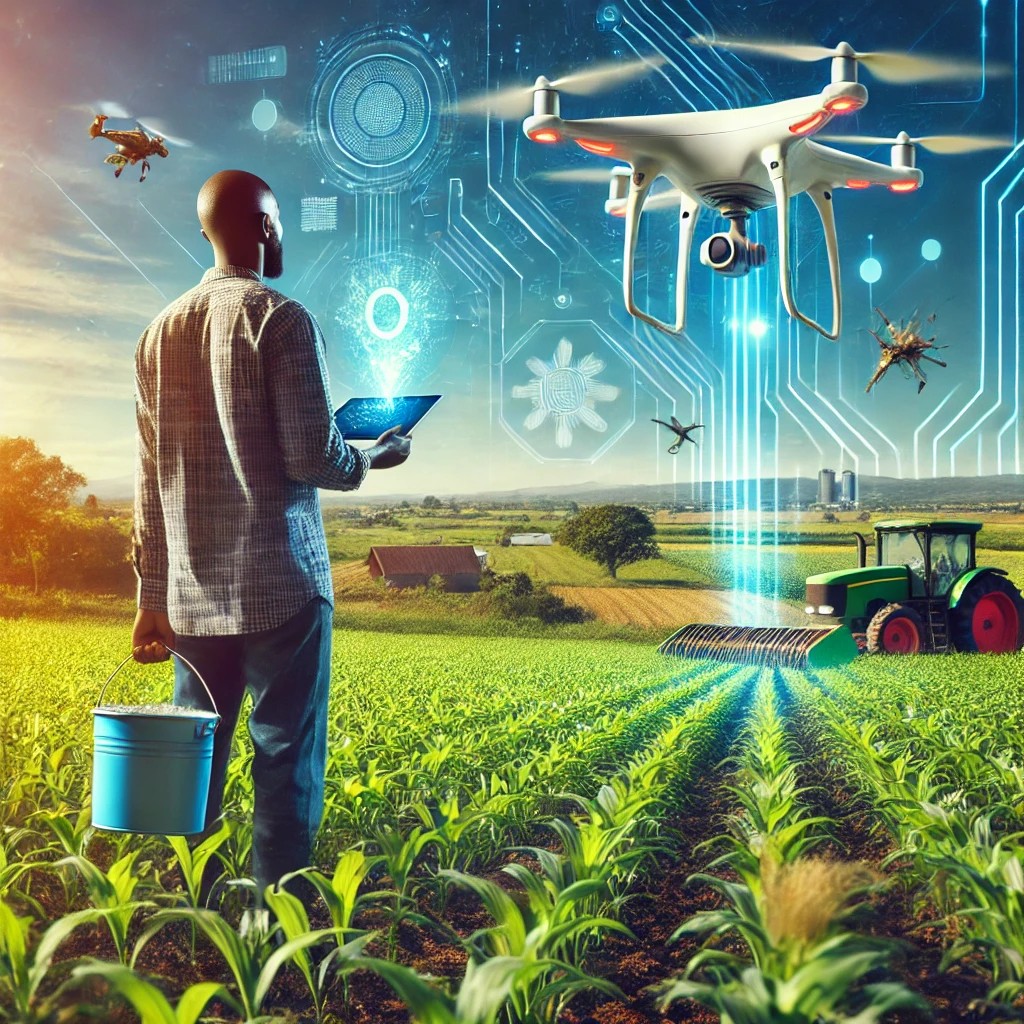INSIGHTS
Analysis
INSIGHTS
AI Revolutionizing African Agriculture: How Technology is Boosting Yields and Securing the Future
The artificial intelligence (AI) is transforming Africa's agricultural sector, helping farmers boost productivity, adapt to climate change, and access new markets. With AI-powered tools for precision farming, weather forecasting, and supply chain optimization, the future of African agriculture looks promising, offering solutions to food security and sustainability challenges across the continent.
 By
Guest |
21 March , 2025 |
By
Guest |
21 March , 2025 |

Image Credit: The mage created using DALL·E
Agriculture plays a pivotal role in Africa's economy, employing over 60% of the continent’s population and contributing around 23% to its GDP, according to the World Bank. Despite this, Africa remains highly vulnerable to food insecurity, climate change, and inefficiencies in agricultural production. Emerging technologies, particularly Artificial Intelligence (AI), have the potential to revolutionize the sector, helping farmers tackle the myriad of challenges they face. This article delves into how AI is transforming agriculture in Africa, breaking down its relevance, deeper implications, and the voices of those impacted.
In Context: Africa's Agricultural Landscape
Africa is home to vast expanses of fertile land, yet it struggles to meet its food demands. The African Union estimates that the continent spends about $35 billion annually on food imports, a figure that is expected to rise to $110 billion by 2025 if current trends persist. Smallholder farmers—who make up the majority of the agricultural workforce—grapple with issues such as low productivity, poor access to markets, erratic weather patterns, and lack of modern farming tools. Despite Africa’s untapped agricultural potential, these barriers continue to impede its capacity to achieve food security and sustainable growth.
This is where AI can make a profound difference. By integrating machine learning, predictive analytics, and automation, AI can enhance decision-making, optimize resource use, and improve crop yields, giving the continent a chance to harness its full agricultural potential.
Go Deeper: How AI is Transforming Agriculture in Africa
-
Precision Farming and Data Analytics
One of the most notable ways AI benefits African agriculture is through precision farming. AI-powered tools and sensors gather data on soil health, moisture levels, crop growth, and weather conditions. Farmers can use this information to make informed decisions about when and where to plant, water, and fertilize crops. For example, Hello Tractor, a Kenya-based startup, uses AI to connect smallholder farmers with tractor owners through a digital platform, optimizing resource allocation and improving productivity.AI can also predict crop diseases and pest infestations. The International Institute of Tropical Agriculture (IITA) has employed AI to develop a smartphone app called Nuru, which helps farmers identify diseases in cassava plants—one of Africa’s staple crops—by analyzing images. This early detection helps farmers mitigate losses and take preventive measures before diseases spread.
-
Weather Forecasting and Climate Adaptation
Climate change has introduced unprecedented challenges to Africa’s agricultural sector, with unpredictable rainfall patterns and frequent droughts becoming the norm. AI-powered climate models and weather prediction tools are providing farmers with more accurate and hyper-local forecasts. Apps like Ignitia, a weather forecasting service tailored for smallholder farmers in West Africa, use AI to deliver precise, location-specific weather data via SMS. This helps farmers plan their planting and harvesting seasons better, reducing losses due to unexpected weather conditions. -
Market Access and Supply Chain Optimization
AI also enhances market access for African farmers, many of whom face difficulties in reaching buyers. Platforms like Twiga Foods in Kenya leverage AI to connect farmers with vendors in urban markets. This AI-driven marketplace provides real-time pricing data, optimizes supply chains, and reduces post-harvest losses. By cutting out intermediaries, AI helps smallholder farmers increase their profit margins and build more sustainable businesses.
What People Are Saying: Voices from the Ground
The adoption of AI in African agriculture has been met with optimism, especially among technology advocates and agricultural experts. A farmer from Ghana, who uses AI-powered drones to monitor his crops, stated: “With AI, I don’t have to guess anymore. I know exactly what’s going on in my field.” This sentiment is echoed by other farmers who have benefited from AI-based tools for disease detection, weather forecasting, and market insights.
However, there are concerns about the accessibility and affordability of AI technology for smallholder farmers. According to a report by McKinsey & Company, only a fraction of Africa’s agricultural workforce currently has access to the internet or smartphones. Without proper infrastructure, AI solutions may only be available to wealthier, larger farms, leaving smallholder farmers at a disadvantage.
Agricultural experts argue that for AI to be truly transformative, it must be accompanied by education and capacity-building initiatives to ensure that all farmers, regardless of their size or wealth, can benefit from it.
Why It Is a Big Deal for Africa
The integration of AI into agriculture is a game-changer for Africa for several reasons. First, it promises to bridge the gap between food production and food demand, helping African nations reduce their reliance on imports. With AI, African farmers can achieve higher productivity and profitability by making data-driven decisions that optimize resources and minimize waste.
Second, AI can help African agriculture become more resilient to the impacts of climate change. As rainfall patterns shift and temperatures rise, AI-powered forecasting and climate models can enable farmers to adapt their practices, ensuring that they are better prepared for extreme weather events. This could be the key to maintaining food security on a continent where millions of people still face hunger.
Finally, AI has the potential to democratize access to markets, allowing smallholder farmers to compete on a level playing field with larger farms. By connecting farmers to buyers, optimizing supply chains, and providing real-time data, AI can help reduce inequality in the agricultural sector and promote sustainable development.
A Future Powered by AI
AI offers immense potential for transforming Africa’s agriculture sector, providing farmers with tools to improve efficiency, adapt to climate change, and access new markets. As more farmers and agricultural organizations embrace AI-driven solutions, the continent could witness a new era of agricultural innovation and food security. However, for this potential to be fully realized, governments and stakeholders must invest in digital infrastructure, training, and capacity-building to ensure that the benefits of AI are accessible to all.
By embracing AI, Africa can not only feed its people but also establish itself as a key player in the global agricultural market.
INSIGHTS
Tech-Driven Tourism: How Innovation is Transforming Africa's Tourism Industry
The transformative impact of technology on Africa's tourism industry, making travel more accessible and enriching.
 By
Guest |
18 March , 2025 |
By
Guest |
18 March , 2025 |

The tourism industry has long been a significant contributor to many African economies. The combination of natural wonders, rich cultures, and historical landmarks continues to attract travelers worldwide. However, as technology reshapes sectors across the globe, tourism in Africa is not being left behind. Innovations like AI, virtual reality (VR), and digital platforms are transforming how travelers experience destinations. But more importantly, these advancements have the potential to create more jobs than other sectors. In South Africa, Tanzania, and Egypt—three of Africa’s top tourist destinations—the integration of technology can expand tourism’s economic footprint even further.
In Context
Tourism is one of the most promising sectors for the African continent. According to the World Travel & Tourism Council (WTTC), in 2019, the tourism sector directly and indirectly contributed 6.9% of Africa’s GDP, supporting 24.6 million jobs. South Africa, Tanzania, and Egypt are among the top countries where tourism plays a pivotal role. In South Africa alone, the sector contributed ZAR 425.8 billion ($29 billion) to the economy, representing 8.6% of GDP and supporting nearly 1.5 million jobs in 2019.
Technology, ranging from AI-driven tourism platforms to digital payment systems, is enabling the sector to scale even further. What’s key to this is that unlike other industries threatened by automation, tourism relies heavily on human-centered services, making it one of the least likely to be fully automated. With new technologies enhancing efficiency, the demand for human workers increases, leading to more job creation.
Go Deeper
AI and Data Analytics
Artificial intelligence (AI) is already playing a crucial role in tourism, especially through personalized customer experiences and efficient service delivery. AI-powered chatbots, for example, help travelers find the best deals, book hotels, or plan itineraries. Companies such as Expedia and Booking.com have already integrated AI chatbots to streamline the customer experience.
For Africa, these innovations are vital. In places like Tanzania, where tourists embark on safaris or climb Mount Kilimanjaro, personalized travel assistance can add immense value to the visitor experience. Moreover, AI-driven analytics can help governments and tourism boards monitor tourist behavior, improve destination management, and create new strategies to attract international travelers.
Virtual Reality and Augmented Reality (VR/AR)
Another technology disrupting tourism is virtual and augmented reality. With VR, potential tourists can explore African destinations virtually before booking their trips. These immersive experiences can showcase wildlife safaris, scenic landscapes, and cultural events in a way that is more engaging than traditional media. Companies like Google are leading the charge with their “Google Expeditions,” which allow users to explore over 900 global destinations in virtual reality.
For instance, South Africa has already started using virtual reality tours to promote its national parks and coastal areas. Egypt, home to the Pyramids and other ancient landmarks, can use augmented reality to enhance visitors’ experiences by providing real-time information about historical sites through AR apps.
Digital Platforms and Job Creation
Digital platforms that connect tourists with local guides, experiences, and accommodations are thriving. Platforms like Airbnb and Viator are bringing more opportunities for local entrepreneurs to tap into the global travel market. In Tanzania, many local communities now offer homestays through digital platforms, providing tourists with more personalized cultural experiences while generating income for local families.
Most importantly, the adoption of these digital platforms significantly contributes to job creation. According to Airbnb’s economic impact report, the platform contributed $6.5 billion to African economies in 2020 alone. With increased internet penetration and mobile phone usage in Africa, these platforms are poised to expand further.
What People Say
Industry Leaders' Viewpoints
In 2022, Gloria Guevara, the former CEO of WTTC, highlighted that “technology will play a key role in recovery post-COVID-19 and beyond, especially in boosting the travel and tourism sector.” She added that “for Africa, tech-driven solutions will not only drive growth but also generate jobs and reduce unemployment.”
African tourism experts also emphasize how the blend of technology and human-centered services in tourism creates a unique space where employment opportunities thrive. The labor-intensive nature of tourism ensures that it doesn’t fall prey to the risks of mass automation, as seen in other industries like manufacturing.
Why It’s a Big Deal for Africa
Tourism stands out as one of the few sectors where technological advancements directly lead to job creation. Unlike sectors such as agriculture or manufacturing, where automation can replace human labor, tourism requires a combination of digital efficiency and human interaction. According to a 2019 International Labour Organization (ILO) report, the travel and tourism sector is among the world’s largest employers, supporting 1 in 10 jobs globally.
In Africa, this is especially important. In Egypt, tourism employs over 2 million people. In South Africa, 1 in 12 jobs is tied to the tourism industry. Tanzania, home to iconic sites like Serengeti National Park, creates hundreds of thousands of jobs through tourism, from guides and hotel staff to transport services. If technology can scale up tourism’s efficiency and reach, it will also scale up job creation.
Beyond direct employment, tourism stimulates other industries such as transportation, hospitality, retail, and food services. In the case of Tanzania, where safari tourism dominates, many rural communities depend on tourism revenue. This sector’s expansion, powered by technology, will also uplift these communities economically.
The Future of Tech-Driven Tourism in Africa
The growth potential for tech-enhanced tourism in Africa is immense. With digital payments, booking platforms, AI-driven insights, and immersive travel experiences, the industry can not only increase its contribution to GDP but also generate millions of jobs across the continent. Countries like South Africa, Tanzania, and Egypt stand to benefit the most due to their well-established tourism infrastructure and global appeal. As these nations continue to adopt technological innovations, tourism will remain a key economic driver for Africa, helping the continent address unemployment and boost its global competitiveness.
Finally, Tech-driven tourism is reshaping how people travel and experience destinations. For Africa, embracing technology in the tourism sector means creating jobs, improving service delivery, and positioning the continent as a top global destination. As countries like South Africa, Tanzania, and Egypt continue to invest in these technologies, they are laying the groundwork for a future where tourism remains a powerful engine of economic growth.
INSIGHTS
How M-PESA Has Become a Global Financial Pioneer: The Western World Is Finally Catching Up
Explore M-PESA’s journey from a revolutionary mobile money service in Kenya to a global fintech leader. Its success has influenced developed markets like the U.S., which are now embracing similar solutions years later.
 By
Guest |
10 March , 2025 |
By
Guest |
10 March , 2025 |

M-PESA, the mobile money service that launched in Kenya in 2007, revolutionized financial services across Africa, offering a solution for millions of people without access to traditional banking. The service has since evolved into an indispensable part of life for many Africans. Eighteen years later, financial systems in the Western world, especially the U.S., are just now catching up to the innovation that M-PESA has provided for years. The analysis delves into how M-PESA evolved into a global leader in financial technology and how the U.S. and other developed markets are beginning to adopt similar solutions.
In Context: The Evolution of M-PESA
M-PESA, originally launched by Safaricom, Kenya's largest telecom provider, started as a simple solution to transfer money via mobile phones. Its success was born from the need to provide financial inclusion in a region where traditional banks were not accessible to many people. By allowing users to deposit, withdraw, transfer money, and even pay for goods and services using a mobile phone, M-PESA bypassed the need for a bank account. Over time, it expanded into a range of services, including savings, loans, and insurance.
Today, M-PESA has over 51 million active users across seven countries, including Kenya, Tanzania, and South Africa, generating billions in transactions daily. In Kenya alone, M-PESA facilitates transactions worth $28 billion annually, according to a report by the Central Bank of Kenya.
Go Deeper: The Western World Finally Catches On
Fast forward to 2025, and financial technology in the U.S. is only now starting to adopt systems that resemble M-PESA’s functionality. One notable example is the rise of apps like Venmo and Cash App, which offer peer-to-peer (P2P) payment services. These apps allow users to send money directly to others, pay for services, and make online purchases. Although these services are popular in the U.S., they lack the comprehensive ecosystem that M-PESA offers in Africa.
For instance, while Venmo and Cash App are primarily limited to P2P transactions, M-PESA allows for more complex functionalities such as paying for utilities, healthcare services, and school fees, and even offering small loans through M-Shwari, a mobile banking service linked to M-PESA. It has created an entire economy that transcends basic banking services.
In the U.S., financial inclusion is also a growing challenge, with nearly 5.4% of households remaining unbanked, according to the Federal Deposit Insurance Corporation (FDIC). Financial services apps like Venmo and Cash App are beginning to play a more significant role in addressing these gaps, especially with the growing demand for digital payments post-pandemic. However, the U.S. financial system still has a long way to go to reach the level of service integration that M-PESA has achieved in Africa.
What People Say: Industry Experts Weigh In
Experts in the fintech industry have lauded M-PESA as a game-changer for financial inclusion. The late Bob Collymore, Safaricom’s former CEO, once said, “M-PESA’s success shows how telecom operators can play a pivotal role in empowering people through mobile money, especially in underserved areas where traditional banking services are not viable.” M-PESA’s ability to evolve and serve the needs of its users, from small-scale entrepreneurs to large corporations, is often highlighted as a key reason for its long-lasting impact.
In contrast, fintech experts in the U.S. are beginning to see the limitations of existing systems. “Peer-to-peer payment apps like Venmo and Cash App have helped democratize digital payments, but they don’t solve the deeper issues of financial inclusion,” says Nicole Casperson, a fintech analyst. “The real breakthrough would be if we can emulate the success of M-PESA and provide comprehensive, accessible services to the unbanked and underbanked communities in America.”
Why It’s a Big Deal for Africa
M-PESA’s success in Africa demonstrates the power of technology to transform economies. By providing a reliable and secure way to manage money, it has empowered millions of people who were previously excluded from the financial system. For rural farmers, small business owners, and people living in remote areas, M-PESA has enabled them to participate in the formal economy and improve their livelihoods.
The broader impact on Africa’s economic development is significant. According to a study conducted by MIT, the availability of M-PESA lifted roughly 2% of Kenyan households out of extreme poverty between 2008 and 2014. The service has also led to a surge in entrepreneurship, as it provides small business owners with a fast and easy way to receive payments and manage finances.
Additionally, M-PESA’s model is now being replicated across other African countries. For example, Tanzania and Ghana have seen similar mobile money services emerge, contributing to the growth of their respective economies. In countries with limited infrastructure, mobile financial services like M-PESA have become the backbone of commerce, reducing reliance on cash and offering new economic opportunities.
Conclusion
Eighteen years after its inception, M-PESA remains a trailblazer in mobile financial services. While the Western world, particularly the U.S., is beginning to adopt similar technologies, the holistic ecosystem provided by M-PESA is unmatched in scope and impact. As countries worldwide grapple with the need for financial inclusion and digital transformation, M-PESA serves as a powerful case study of how technology can foster economic growth and improve lives. For Africa, M-PESA is not just a financial tool—it’s a revolutionary system that continues to drive development and set the standard for financial inclusion globally.